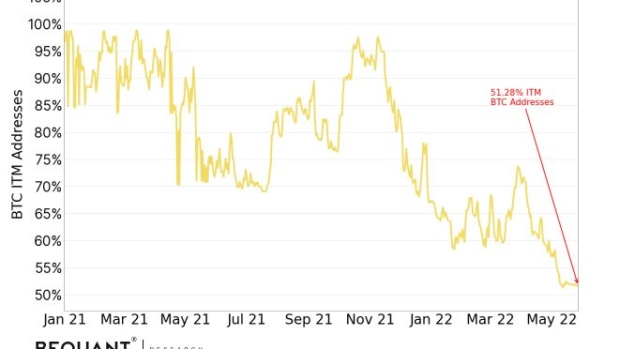Jun 8, 2022
Crypto In-the-Money Traders Dwindle, Hinting at Capitulation
, Bloomberg News

(Bloomberg) -- More crypto traders are finding their Bitcoin investments underwater and may be ready to throw in the towel.
The number of anonymous Bitcoin addresses in the money, meaning those that acquired their holdings at prices below today’s, has reached lows not seen since March of 2020, according to Bequant, a digital-asset firm. The level, currently hovering around 51%, “points to capitulation,” though bear markets in 2015 and 2018 saw even lower lows, wrote Martha Reyes and Emiliano Bruno in a note.
Crypto prices have been in a slump this year as the Federal Reserve withdraws stimulus and hikes rates to combat inflation. The environment has been toxic for all manner of riskier assets, including richly valued tech companies. But cryptocurrencies have been hit particularly hard, with Bitcoin losing more than a third of its value this year, and others, including Ether, shedding 50%. Even Bitcoin miners have started to offload tokens they had hoarded as many are seeing few signs prices could recover soon.
“It feels very much to me like crypto is also subject to a lot of the monetary cycle that’s been hitting the more traditional asset classes,” Kara Murphy, CIO of Kestra Holdings, said. “Looking at the rapid increase in crypto prices, it seems clear that they really benefited from easy-money policies, and now that the money is coming out of the system, that’s a good part of the reason why crypto is declining more recently.”
In its second consecutive session lower, Bitcoin fell as much as 4.8% on Wednesday to trade around $29,800.
Read more: Bitcoin Miners Are Selling Tokens as Prices Linger Near Lows
With prices trading at the lower end of the last 17-month range, the bulk of buyers over that span are holding unrealized losses, according to strategists at Glassnode, who cite something called the Net Unrealized Profit/Loss metric, or NUPL, which maps out unrealized profits and losses as a proportion of market value. Since early May, the measure has fluctuated in a range of around 18% to 25%, “indicating less than 25% of the market cap is held in profit,” they wrote. They say the $20,560 to $23,600 span is where the measure “would imply a full-scale capitulation scenario.”
To be sure, it’s unlikely that a lot of crypto “OGs”, meaning those who bought early on at very low price levels, are dumping their holdings, said Wilfred Daye, chief executive officer of Securitize Capital, a digital-asset management firm. But those who bought in recent months might be more likely to sell.
“There may be capitulation because larger institutional players, guys who got in during the current cycle, they’re at risk of selling their assets and liquidating their assets,” Daye said. “This particular cycle that started late 2020, you had a lot of institutional folks getting in at a higher price, so I think it’s more institutional capitulation.”
And sentiment remains sour still. The Bitcoin put-to-call ratio hit a recent high of 0.75 last week, according to Skew data compiled by Babel Finance.
That indicates that “traders continue to buy puts for price protection or look to profit from BTC’s price decline,” Babel strategists wrote in a note.
(Updates with additional loss details in sixth paragraph.)
©2022 Bloomberg L.P.





